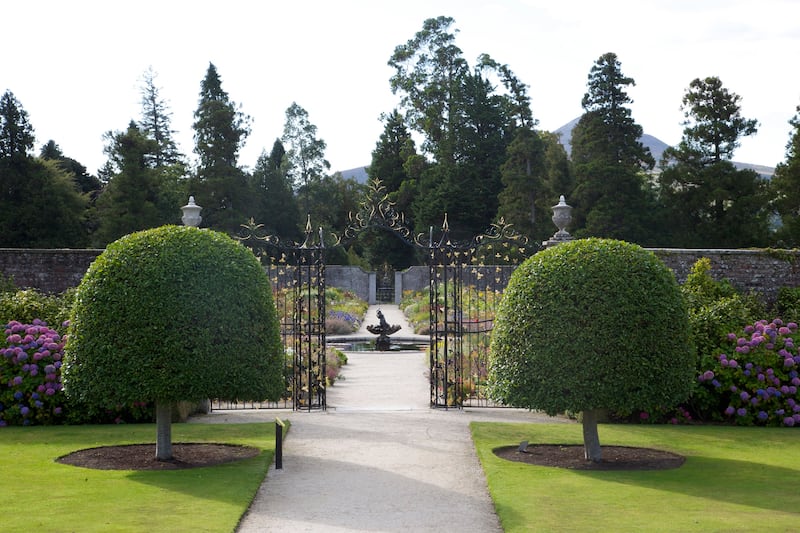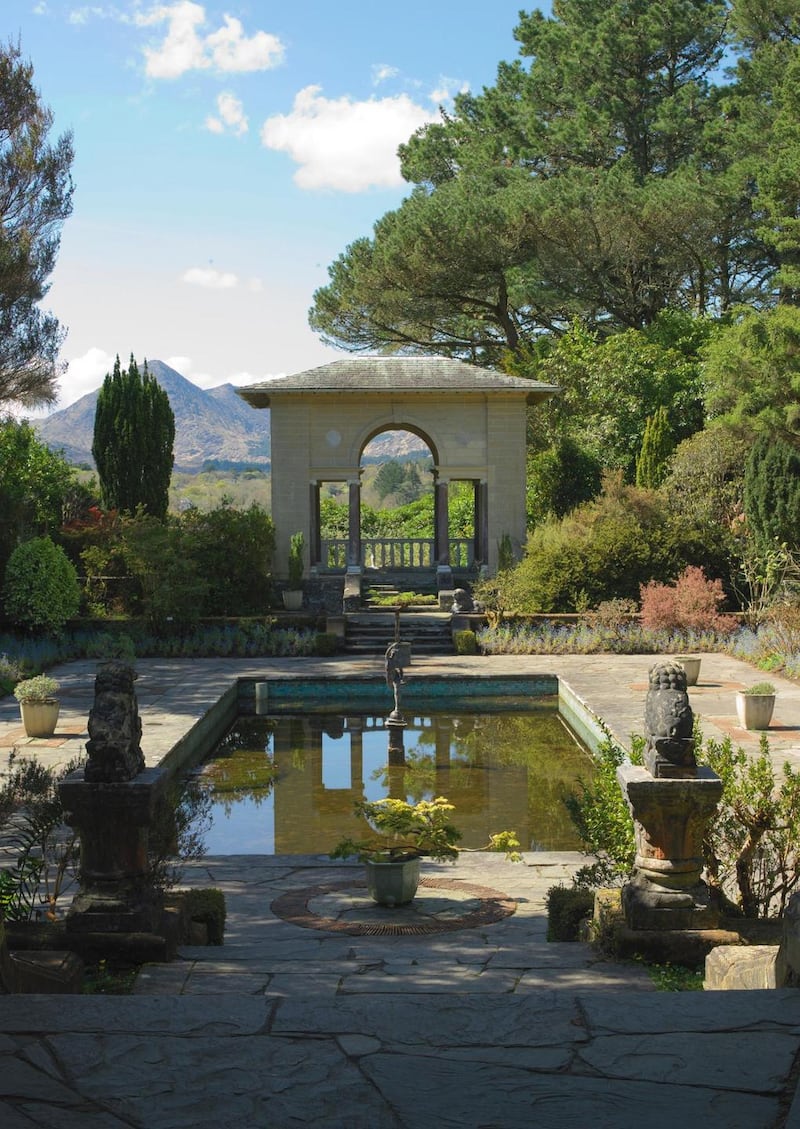As someone who’s all too easily intoxicated by the frothy seasonal beauty of a garden in high summer, I make a point of regularly reminding myself of the irreplaceable role that woody evergreen species play in winter. But even if I didn’t, it becomes impossible to ignore at this time of year.
Much like what high cheekbones – or what Jane Austen famously describes as “a fine pair of eyes”- can do for a face, these plants give an all-important sense of structure and enduring beauty long after herbaceous species have disappeared below ground and deciduous species, their branches unclothed, have gone into deep hibernation.
The best have a presence all their own, one graphically underscored when their leafy silhouettes are thoughtfully manipulated into a variety of sculptural, human-made shapes and forms. This might be a solitary yew tree clipped into a leafy green cone, or a skirt-lifted Portuguese laurel with its lower branches artfully removed. Or it could be a low, silvery, undulating hedge of aromatic rosemary, a prickly obelisk of holly, or a cloud-pruned pine tree or podocarpus.
Despite the recent challenges of pests and disease, box (buxus) also remains unrivalled in its ability to tolerate regular clipping, a quality that allows this ultra-hardy woody evergreen to be trained into an endless variety of shapes, from the pleasing geometric symmetry of cones, spheres, spirals and cubes to softly billowing curves, clouds and plumes.
Bonsai-trained evergreen species of trees and shrubs are yet another example of the magical ways in which artfully pruned plants can enliven even the tiniest of city gardens in winter, using hardy coniferous species such as pine, juniper, yew, spruce and escallonia skilfully trained into miniature, stylised versions of themselves.
The art and craft of sculpting woody evergreen species in these kinds of ways has a very long history stretching back many centuries.
Topiary, for instance, was already well-established by the Roman era and the reign of Augustus Caesar, reaching its apogee in the late 17th century formal gardens of Versailles. Other famous topiary gardens from the same period include Les Jardins de Marqueyssac in Dordogne and Leven Hall in the UK. Much closer to home are the formal Italianate gardens of Powerscourt in Co Wicklow, on which work began in the mid-19th century.
Fantastical examples of topiary gardens include those that feature in Stephen King’s book, The Shining, where its topiary animals come eerily to life, as well as those in Tim Burton’s gothic fantasy movie Edward Scissorhands, with its giant whimsical creatures carved from box.
Modern real-life examples include the majestic parterres of privately owned Castletown Cox in Co Kilkenny, designed by the late Dowager Duchess of Salisbury in the 1990s. Like something straight out of the pages of Alice in Wonderland, impeccably clipped yew, box, evergreen oak, bay and Osmanthus burkwoodii plants have been used to create intricately beautiful, interlinking patterns featuring elaborate scrolls, swirls, flourishes and cones on a grand scale.




Another outstanding contemporary example is Balmoral Cottage in Kent, the wonderfully idiosyncratic creation of British gardeners Charlotte and Donald Molesworth. Made over the past 40 years on a shoestring budget (almost every plant in it was grown from cuttings) but with the boundless artistry of its owners, it features giant topiary peacocks, dogs and chess pieces carved from box and yew.
Originating from the 2,000-year-old Chinese tradition of miniaturising container-grown trees known as “penjing”, the Japanese art of bonsai has similarly endured the passing whims of fashion, with many devoted practitioners in this country (see bonsai.ie and budgardencentre.com).
Modern examples of the art include Longwood Garden in Pennsylvania’s recently opened outdoor bonsai courtyard, a permanent exhibition of almost 200 outstanding bonsai trees. Recently gifted to the gardens, a substantial number come from the privately owned Kennett Collection created by owner Doug Paul in recent decades following his extensive visits to many of Japan’s most famous nurseries as well as to some of the world’s most renowned bonsai artists. Examples include a Japanese white pine tree (Pinus parviflora ‘Miyajima’) originally trained by bonsai master Masahiko Kimura, aka “The Magician”, who began work on it back in the 1940s.
But this octogenarian is only a stripling compared to the famous bonsai tree known as the Yamaki pine. Believed to be several hundred years old and a survivor of the bombing of Hiroshima, it was donated to the National Bonsai and Penjing Museum at the United States National Arboretum in Washington in 1976 by its owner, bonsai master Masaru Yamaki, who also miraculously survived the same blast that damaged his home and nursery at Hiroshima. Also known as the Peace Tree, the Yamaki pine was owned by his family for six generations.



Much closer to home in Newtownards, Co Down, Ian Young has created a substantial collection of bonsai trees over the past number of decades, sharing his expert, painstaking work through his blog as well as his Instagram feed @bonsaieejit. Young also worked as a consultant on the recent restoration of the bonsai trees that grow in the sunken gardens of Ilnacullin-Garinish Island in Bantry Bay. The latter is now in the very capable hands of OPW gardener Glyn Sherratt, who has also reinstated its topiary peacocks as part of OPW’s ongoing extensive restoration and rejuvenation of this historic Irish garden.
All of the above are rich proof of the enduring beauty that comes from the skill, artistry, vision and – just as importantly – the patience of exceptional gardeners. It’s a lesson I’m trying to put into practice in my own garden by resisting the temptation to seek out near-instant results. Instead I’m dreaming of some giant yew chess pieces, a half dozen oversized box balls and perhaps a couple of bonsai by the front door. Maybe even a giant yew cat in honour of the garden designer Gertrude Jekyll, who had one in her own garden at Munstead Wood. Of course they’ll take decades to coax into life, but then, allowing time to work its magic is an important part of the complicated joy of being a gardener ...
This week in the garden:
As herbaceous plants die back down to ground level and deciduous species lose their leaves, take the opportunity to seek out suitable locations in your garden for some evergreen plants to give it structure, scale, and year-round interest.
Garden birds will soon start to strip the ripe berries from holly bushes so if you want to use some berried branches as Christmas decorations, then either net them now or cut them and then put them in a bucket of water in a cool, dark shed until required.
Dates for your diary
An Evening with Tom Hart Dyke, an illustrated Zoom talk by the adventurer, explorer, horticulturist and plant hunter on behalf of the RHSI. Wednesday, November 19th (7.30pm), members free, guests €8, see rhsi.ie















